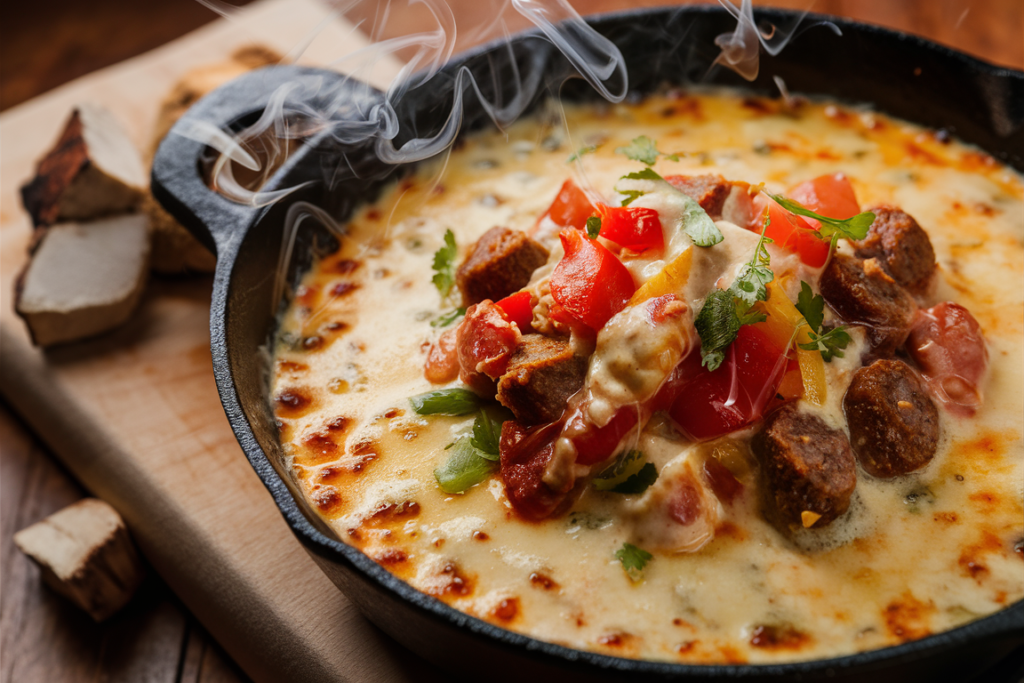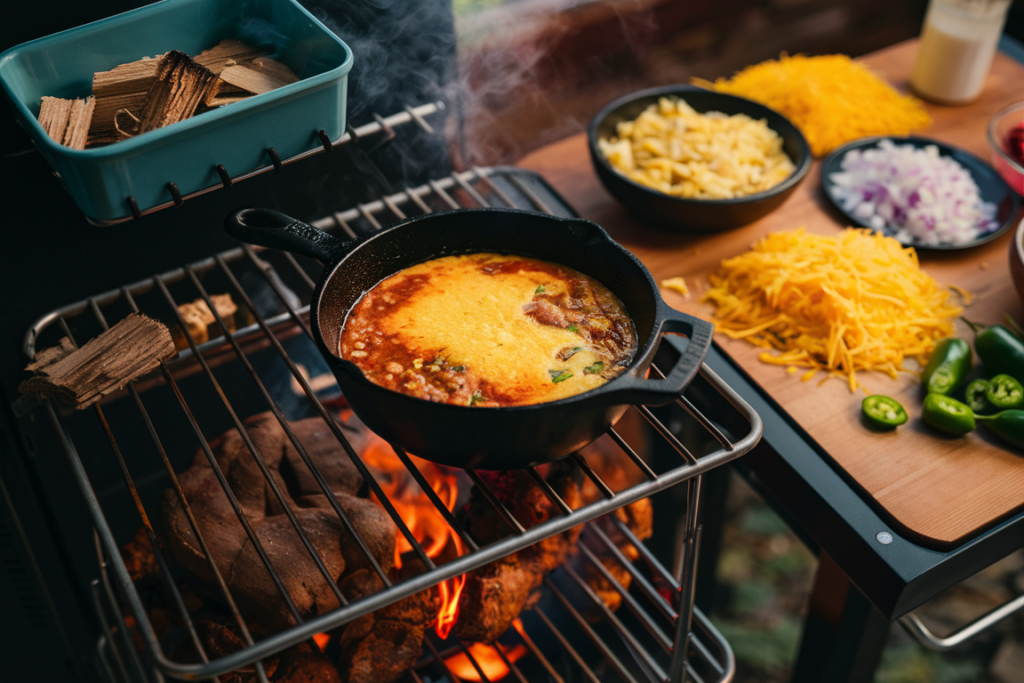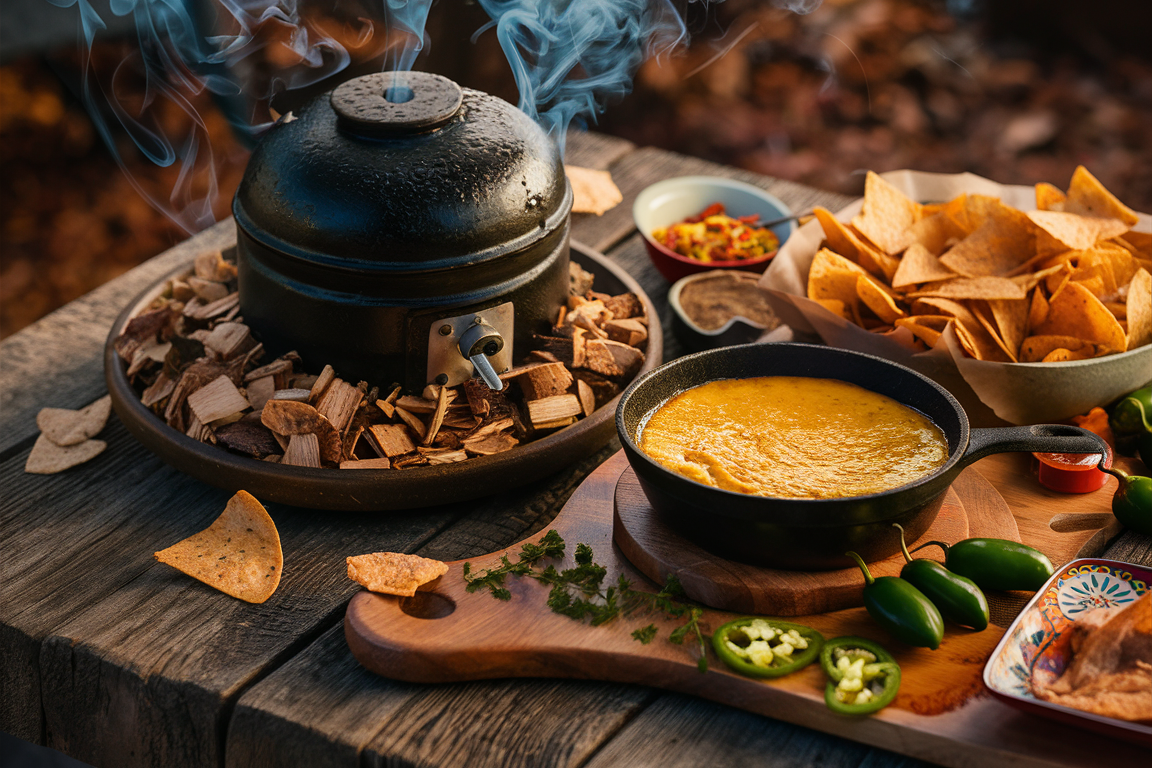Part 1: Understanding Smoked Queso
What is Smoked Queso?
Smoked queso has revolutionized how we enjoy cheese dips, bringing a rich, smoky flavor that elevates traditional recipes. Unlike standard queso, which is melted cheese with added ingredients, smoked queso gets its distinctive taste from the wood chips used during the smoking process. The cheese is exposed to aromatic wood smoke in a smoker or grill, creating a deep, layered flavor profile that’s impossible to replicate with other cooking methods.
This technique has gained immense popularity in recent years, not only for its tantalizing taste but also for its versatility. Whether you’re preparing a classic Tex-Mex queso or experimenting with gourmet additions like chorizo or roasted peppers, smoking the cheese adds a gourmet twist that transforms the dish.

Benefits of Smoking Queso for Flavor
Smoking queso offers more than just a fancy presentation. Here’s why it’s worth trying:
- Enhanced Flavor Depth: The smoky aroma and taste meld seamlessly with the creamy texture of cheese, creating a dynamic flavor that’s perfect for parties, barbecues, or casual get-togethers.
- Customizable Profiles: You can easily adjust the smokiness by choosing different woods, which can impart fruity, nutty, or bold notes.
- Versatile Applications: Smoked queso pairs beautifully with chips, tacos, and even as a topping for burgers or nachos.
Learn how to set up your smoker for queso here.
The Role of Wood in Smoking
Why Wood Choice Matters for Smoking
The type of wood you select for smoking plays a critical role in the flavor and aroma of your queso. Different woods produce unique smoke profiles, ranging from mild and sweet to bold and earthy. The wrong wood can overwhelm the cheese’s delicate flavors, while the right one can elevate it to perfection.
Key factors influenced by wood choice include:
- Flavor Intensity: Stronger woods, like hickory or mesquite, add bold, robust flavors. Lighter woods, like apple or pecan, provide subtler, sweeter undertones.
- Burn Characteristics: Some woods burn hotter or longer, affecting the consistency of the smoke during the cooking process.
Discover which wood chips to buy for smoking here.
How Wood Affects the Texture and Aroma of Queso
The smoking process doesn’t just alter flavor—it can also impact the queso’s texture and aroma:
- Texture: Light smoking enhances the creaminess of the cheese without altering its meltability, while heavy smoking can cause a slight crust to form.
- Aroma: The wood smoke infuses the queso with an inviting aroma, making it a showstopper at any gathering.
Popular Woods for Smoking
Overview of Common Smoking Woods
Several woods are commonly used for smoking, each offering distinct characteristics:
- Applewood: Mild and slightly sweet, ideal for enhancing cheese without overpowering it.
- Hickory: Bold and smoky, suitable for creating a classic BBQ flavor.
- Cherrywood: Fruity and subtly sweet, it pairs well with spicier cheeses.
- Mesquite: Strong and earthy, best reserved for robust cheese flavors.
- Pecan: Sweet and nutty, perfect for adding complexity to lighter cheeses.
Characteristics of Fruity vs. Strong Woods
- Fruity Woods: Examples include apple and cherry. These woods impart a light, sweet flavor that works well with mild or spicy cheeses.
- Strong Woods: Woods like hickory and mesquite offer a bold, intense smokiness that pairs better with sharp or aged cheeses.
Matching Wood to Cheese Types
How Different Cheeses React to Different Woods
Cheese types vary in fat content, moisture, and flavor, all of which influence how they interact with different woods:
- Soft Cheeses: Brie or mozzarella absorb smoke more quickly and require milder woods to avoid overpowering their delicate taste.
- Hard Cheeses: Cheddar or Gouda benefit from stronger woods that complement their bold flavors.
Perfect Pairings: Mild Cheeses and Woods
Pairing the right wood with the cheese type ensures the best results:
- Applewood with Monterey Jack: The subtle sweetness of applewood enhances the creamy texture of Monterey Jack.
- Cherrywood with Pepper Jack: Cherrywood’s fruity notes balance the heat of spicy cheeses.
- Pecan with Havarti: The nutty sweetness of pecan adds depth to the buttery flavor of Havarti.
Part 2: Best Woods for Smoking Queso
Overview of Top Recommendations
When it comes to smoking queso, the type of wood you choose will dramatically affect the end result. The following woods are considered the best for enhancing the natural creaminess and flavor of cheeses while providing a rich, smoky profile.

Let’s dive deeper into the top choices:
- Applewood
- Hickory
- Cherrywood
- Mesquite
- Pecan
These woods offer varying levels of sweetness, smokiness, and intensity, making them versatile for pairing with different cheese types and additional ingredients like jalapeños, sausage, or onions.
1. Applewood
Subtle Sweetness: Why Applewood is Ideal
Applewood is a go-to choice for smoking queso due to its light, sweet, and fruity smoke profile. It enhances the flavor of cheese without overpowering it, making it an excellent option for beginners or those who prefer subtle smokiness.
Key Features:
- Provides a gentle, aromatic flavor.
- Burns at a steady temperature, ideal for queso.
Best Cheese Types to Smoke with Applewood
Applewood works particularly well with mild, creamy cheeses like:
- Monterey Jack
- Mozzarella
- Havarti
These cheeses absorb the delicate sweetness of applewood, resulting in a smooth, harmonious flavor.
2. Hickory
Bold and Smoky: The Strength of Hickory
If you’re looking for a bold and classic smoky flavor, hickory is a perfect choice. Known for its robust, savory profile, hickory adds a rich depth to the cheese, making it ideal for those who enjoy stronger flavors.
Key Features:
- Offers a distinctly smoky taste.
- Best used in moderation to avoid overpowering the queso.
Balancing Hickory with Cheese Intensity
Hickory pairs best with cheeses that can stand up to its boldness, such as:
- Sharp Cheddar
- Gouda
- Colby Jack
Adding smoked meats like bacon or brisket to your queso can further complement the hickory’s strong profile.
3. Cherrywood
Adding a Fruity Twist to Queso
Cherrywood is known for its light, fruity smoke that adds a subtle sweetness and reddish hue to smoked dishes. It’s an excellent choice for queso recipes with a spicy kick, as it balances out the heat with a pleasant sweetness.
Key Features:
- Imparts a mild, fruity flavor.
- Adds a visually appealing color to the cheese.
Combining Cherrywood with Spicy Cheese
Pair cherrywood with cheeses like:
- Pepper Jack
- Queso Fresco with jalapeños
- Smoked Provolone
The fruity undertones of cherrywood complement the spiciness, creating a layered flavor profile that is both sweet and smoky.
4. Mesquite
When to Use Mesquite for Smoked Queso
Mesquite is known for its strong, earthy flavor, making it best suited for experienced smokers or recipes that call for boldness. It burns hot and fast, so careful monitoring is necessary to prevent over-smoking.
Key Features:
- Produces a strong, earthy smoke flavor.
- Ideal for short smoking sessions.
Pairing Mesquite with Stronger Cheese Flavors
Mesquite pairs well with assertive cheeses like:
- Blue Cheese
- Aged Cheddar
- Smoked Gouda
Use mesquite when your queso includes bold ingredients like chorizo or chipotle peppers, as it complements their intensity.
5. Pecan
A Nutty Sweet Option for Delicate Cheeses
Pecan wood offers a sweet, nutty flavor that is perfect for delicate cheeses. Its mild profile makes it a versatile choice for those who prefer a balanced, nuanced smokiness.
Key Features:
- Combines mild sweetness with a nutty aroma.
- Burns slowly and evenly, allowing for consistent smoking.
Perfect Matches: Pecan and Mild Cheeses
Pair pecan wood with:
- Havarti
- Monterey Jack
- Brie
The subtle flavor of pecan enhances the creaminess of these cheeses, making it ideal for gourmet queso recipes.
Tips for Smoking Queso
Preparing the Cheese for Smoking
Proper preparation ensures that your queso absorbs the maximum flavor:
- Shred or Cube the Cheese: This allows more surface area for the smoke to penetrate.
- Use a Cast Iron Skillet: Cast iron distributes heat evenly and prevents sticking.
- Add Ingredients Gradually: Start with your base cheese, then layer in extras like diced tomatoes, peppers, or meats.
Achieving the Right Smoke Balance
Finding the perfect balance of smoke is essential for a flavorful queso:
- Avoid Over-Smoking: Too much smoke can result in a bitter, overpowering taste.
- Use a Mix of Woods: Combine mild and bold woods for a layered flavor profile.
Setting Up Your Smoker
Achieving the right temperature and consistency is key:
- Optimal Temperature: Keep your smoker between 200-225°F to avoid burning the cheese.
- Wood Chip Management: Soak wood chips beforehand to ensure a slow, steady release of smoke.
Experimenting with Flavors
Smoked queso is a blank canvas for flavor experimentation:
- Mix Multiple Woods: Combine applewood and hickory for a sweet and smoky taste.
- Infuse Herbs and Spices: Add rosemary, thyme, or smoked paprika during the smoking process for extra depth.
Common Mistakes to Avoid
Avoid these pitfalls for a perfect smoked queso:
- Over-Smoking: Too much exposure to smoke can ruin the queso’s creamy texture and flavor.
- Choosing the Wrong Cheese-Wood Combination: Mismatched pairings can result in unbalanced flavors.
Part 3: Tips for Smoking Queso: Mastering the Process
Preparing the Cheese for Smoking
Proper preparation is the foundation of achieving perfectly smoked queso. Without these steps, the cheese may not absorb the smoky flavors evenly or could burn during the process.

- Choose the Right Cheese: Opt for cheeses that melt smoothly, such as:
- Velveeta
- Monterey Jack
- Cheddar
- Colby Jack
- Pre-Smoking Setup: Before placing the cheese in the smoker, preheat it to the ideal temperature (200–225°F) to ensure even cooking.
- Use a Heatproof Dish: A cast iron skillet is highly recommended for its ability to retain heat and distribute it evenly.
- Incorporate Ingredients Strategically: Add extras like diced tomatoes, onions, or jalapeños after the initial smoking for a burst of freshness.
Achieving the Right Smoke Balance
Too much or too little smoke can drastically affect the queso’s outcome. A balanced approach ensures the smoky flavor complements the cheese without overpowering it.
- Monitor Smoke Color: Aim for thin, blue smoke rather than thick, white smoke, which can impart bitterness.
- Time Your Smoking: For queso, 1–2 hours of smoking is usually sufficient to achieve a rich flavor without overdoing it.
- Use Ventilation Wisely: Open the smoker vents to maintain proper airflow, which helps regulate the temperature and smoke density.
Setting Up Your Smoker
A smoker setup tailored for cheese is crucial to prevent the cheese from overheating or curdling. Here are the essential steps:
- Preheat Gradually: Allow the smoker to reach a stable temperature before adding wood chips.
- Use a Water Pan: Adding a pan of water helps maintain moisture inside the smoker, preventing the cheese from drying out.
- Positioning: Place the queso mixture on an upper rack, away from direct heat, for indirect smoking.
Experimenting with Flavors
The beauty of smoked queso lies in its versatility. Once you’ve mastered the basics, try experimenting with wood combinations and additional flavors.
Combining Multiple Woods for Complex Flavors
- Applewood + Cherrywood: Offers a sweet, fruity base with a hint of tartness.
- Hickory + Pecan: Combines bold smokiness with a nutty sweetness for depth.
- Mesquite + Cherrywood: Balances the earthy intensity of mesquite with a fruity twist.
Infusing Spices and Herbs During Smoking
- Add fresh herbs like rosemary or thyme to the wood chips for a subtle, herbal aroma.
- Mix spices like smoked paprika or chili powder directly into the queso mixture for an extra kick.
Common Mistakes to Avoid
To achieve perfectly smoked queso, steer clear of these frequent errors:
Over-Smoking and Its Effects on Queso
Too much smoke exposure can result in:
- A bitter, acrid taste that masks the cheese’s natural flavor.
- A gritty texture caused by prolonged heat exposure.
Choosing the Wrong Cheese-Wood Combination
Matching the cheese with an inappropriate wood can lead to unbalanced flavors. For example:
- Strong woods like mesquite may overwhelm mild cheeses like mozzarella.
- Fruity woods like cherrywood may not stand up to bold cheeses like sharp cheddar.
Perfect Smoked Queso Recipe for Beginners
Here’s a step-by-step guide to creating a classic smoked queso that showcases the harmony between cheese and wood smoke.
Ingredients
- 1 lb Velveeta cheese, cubed
- 1 cup shredded Monterey Jack
- 1 cup shredded sharp cheddar
- 1 can diced tomatoes with green chilies
- 1/2 cup diced onions
- 1/2 cup cooked and crumbled sausage or chorizo
- 1–2 jalapeños, diced
- Wood of choice (applewood or cherrywood recommended)
Instructions
- Preheat the Smoker: Set your smoker to 225°F and add your chosen wood chips.
- Prepare the Cheese Mixture: Combine all ingredients in a cast iron skillet.
- Smoke the Queso: Place the skillet on the smoker and cook for 1–2 hours, stirring every 30 minutes for even smoking.
- Finish and Serve: Once the cheese is fully melted and infused with smoke, remove it from the smoker and serve with tortilla chips or veggies.
More FAQs on Smoking Queso
1. Can I use a gas grill instead of a smoker?
Yes! Add a smoker box with wood chips to your grill, and use indirect heat to mimic a smoker’s environment.
2. How long should I smoke queso?
1–2 hours is usually sufficient for queso, depending on your desired smokiness.
3. Which cheese melts best for smoked queso?
Velveeta, Monterey Jack, and cheddar are top choices for their smooth melting properties.
4. Can I mix multiple woods for smoking?
Absolutely. Combining woods like apple and hickory allows for complex flavors.
5. How do I prevent my queso from drying out?
Use a water pan in the smoker to maintain moisture, and keep the temperature consistent.
6. Is it possible to over-smoke queso?
Yes. Too much smoke can lead to bitterness, so monitor the smoke level carefully.
7. What’s the best wood for spicy queso?
Cherrywood works well to balance spicy flavors, while hickory enhances the heat.
8. Should I stir the queso while it’s smoking?
Yes. Stirring every 30 minutes ensures even melting and smoke absorption.
9. Can I add beer or broth to the queso mixture?
Yes! Adding beer or broth enhances the flavor and prevents the queso from thickening too much.
10. What’s the easiest wood to work with for beginners?
Applewood is a great choice for beginners due to its mild, forgiving flavor profile.

